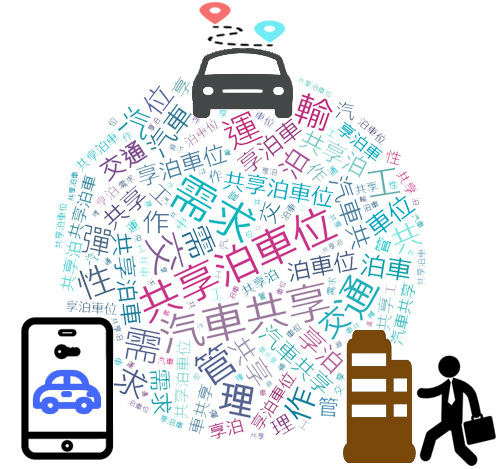ISE09/20-21
| 主題: | 交通 |

- 交通需求管理一般指採取策略和措施,重新分配對不同交通工具的需求及/或減少交通需求,從而更有效地運用交通資源。1註釋符號代表請參閱MRCagney (NZ) Ltd (2020)。 交通需求管理被視為發展可持續運輸系統的重要一環。概括而言,交通需求管理措施可分類為:(a)更好的交通選擇;(b)經濟誘因/懲罰措施(如道路使用費);(c)土地使用規劃和發展(如泊車管理);及(d)推動改變乘車習慣的計劃(如減少車程次數的計劃)。2註釋符號代表同上。 交通需求管理如行之有效,可為社會帶來不少禆益,例如減少擠塞、節省交通開支及改善環境質素。
- 香港道路空間有限,為確保交通暢順及利便市民出行,有效的交通需求管理措施尤為重要。香港的運輸政策以公共交通服務為主,並以鐵路為骨幹。與此同時,政府亦透過各項措施改善交通,例如徵收隧道費和加強打擊與交通擠塞相關的罪行。儘管近月爆發2019冠狀病毒病疫情,導致經濟活動放緩,乘客人次亦因而減少,但路面交通繁忙、停車場不足,以及部分鐵路線在繁忙時間負荷過重等問題,在過去10年一直備受關注。
- 南韓首爾以智能城市為其定位,近年積極以新科技改善運輸系統。在2013年,首爾發表名為《首爾交通願景2030》的長遠願景計劃。該計劃旨在推行多項需求控制措施,長遠改善運輸系統。本期《資訊述要》先綜述香港的交通需求管理策略及交通情況,繼而討論首爾市政府管理市內交通需求的經驗和措施,當中或有可供香港參考借鑒之處。
香港
- 近月的2019冠狀病毒病疫情雖然令經濟活動與交通需求大減,但香港路面交通擠塞問題持續多年,一直備受關注。本港的汽車行程速度日趨緩減,反映交通擠塞情況有惡化跡象。舉例而言,新界區平日早上繁忙時間平均車速已由2009年每小時42.9公里,減至2019年的每小時38.3公里。3註釋符號代表與此同時,在2009年至2019年間,香港島的汽車行程速度由每小時21.3公里輕微回升至每小時21.5公里,而九龍區的汽車行程速度則由每小時24.9公里減至每小時20.6公里。請參閱Transport Department (2010及2020a)。 另一方面,截至2019年年底,本港領牌車輛總數超逾79萬輛,較2009年高出約36%。4註釋符號代表請參閱Transport Department (2009及2019a)。 為應付持續增加的交通需求,政府透過以下途徑推行多項供求管理措施:(a)改善交通基建;(b)擴展和改善公共交通系統;及(c)管理道路的使用。例如,政府一直拓展鐵路網絡,並與專利巴士公司合作推行巴士路線重組,以及設置限制區禁止路旁上落客貨活動。5註釋符號代表請參閱Transport and Housing Bureau (2015)。
- 車輛數目持續增加,當中特別是私家車的數目,是本港路面交通繁忙的主因。這類車輛佔車輛總數超過70%,在大部分主要道路的交通流量亦佔40%至70%。6註釋符號代表請參閱Transport Advisory Committee (2014)。 由於就實施電子道路收費計劃以紓緩交通擠塞所展開的研究仍在進行中,7註釋符號代表最近,政府建議在中環核心區推行先導計劃,並成立國際專家小組,負責就推展先導計劃向政府提供意見。請參閱Transport Department (2020b)。 政府基本上繼續依靠首次登記稅及牌照年費以控制私家車數目。根據政府委託的《香港智慧城市藍圖顧問研究報告》,8註釋符號代表請參閱PwC (2017)。 推廣以租用為本的汽車共享服務,有助減少整體私家車數目,因為司機可按需要使用車輛而無須擁有汽車。9註釋符號代表汽車共享指就使用出租汽車收取租金的汽車服務,當中並不包括提供司機。有別於以未獲出租汽車許可證的車輛載客取酬的網約車服務,汽車共享服務如有適當保險保障,即符合現行法例。這類服務由於屬按次收費,被認為相對傳統租車服務較具彈性。 政府回應一項立法會質詢關於個人化點對點交通服務時表示,汽車共享服務已在市場上出現,而部分市民亦有使用有關服務。因此,政府未有將這類服務納入《香港智慧城市藍圖》。10註釋符號代表請參閱GovHK (2018)。
- 除了路面車輛過多,車輛兜圈找尋泊車位亦常令市區交通受阻。11註釋符號代表截至2018年年底,本港約有76萬個公眾泊車位可供市民使用,較2008年輕微上升9%,明顯低於同期車輛數目36%的升幅。 為紓緩泊車位不足,尤其是商用車輛泊車位不足的情況,政府一直有在合適的"政府、機構或社區"設施提供公眾泊車位,並已推展自動泊車系統先導計劃,作為智慧出行措施之一。12註釋符號代表政府表示已預留8幅合適的"政府、機構或社區"設施和公共休憩用地,用作興建主要供商用車輛使用的停車場。此外,政府亦正推展6個自動泊車系統先導項目。請參閱Transport and Housing Bureau (2019)及GovHK (2020)。 在2019年4月,審計署就香港《公眾泊車位的規劃、提供和管理》發表檢討報告,13註釋符號代表請參閱Audit Commission (2019)。 其中向政府提出多項建議,包括提供更多長期公眾泊車位及改善泊車資訊的發放。14註釋符號代表立法會政府帳目委員會經考慮審計署的報告後,對政府未有採取適當行動表示極度遺憾。請參閱Legislative Council Secretariat (2019)。
- 一如不少其他城市,香港經常鼓勵市民乘搭公共交通,藉此管理交通需求。15註釋符號代表請參閱The University of Sydney Business School (2020)。 然而,本港市民已甚為依賴公共交通,在每日載客人次中,公共交通乘客佔90%。在繁忙時間,部分繁忙鐵路線的載客量甚至超過100%。因此,政府在跨越2030年的策略規劃16註釋符號代表"香港2030+:跨越2030年的規劃遠景與策略"於2016年發表,這項策略計劃旨在為香港跨越2030年的規劃、土地及基建發展,以至建設環境的塑造提供指引。請參閱Development Bureau (2016)。 中,建議透過空間規劃,重塑市民日常出行的模式,從而減少以車輛代步的需要。其中,政府會在新發展區及主要市區範圍外劃定更多與就業相關的土地用途,令市民無須長途跋涉上班。相關措施的詳情有待公布。
首爾的交通需求管理策略
- 過往,首爾的交通管理主要以收費/限制措施為本。例如,首爾在1990年引入擠塞影響費(congestion impact fee),向設施擁有人徵收年費,藉以收回用於發展及改善交通基建的部分成本。17註釋符號代表請參閱Seoul Solution (2017c)。 為處理市內持續不斷的交通擠塞問題,首爾在1990年代於指定地區(南山1號和3號隧道)實施擠塞徵費(congestion charge)18註釋符號代表請參閱Seoul Solution (2017a)。,以遏制交通需求,並在某些繁忙地區推出泊車上限計劃,限制泊車位興建數目。以上措施推出後,當地平均汽車行程速度曾逐漸增加。
- 然而,2000年代經濟發展蓬勃,刺激交通需求增長,導致交通擠塞及空氣污染惡化。為使當地更宜居及減少對車輛的依賴,首爾市政府在2013年公布一項長遠交通需求管理總綱規劃,名為《首爾交通願景2030》("願景計劃"),作為未來20年的交通政策基礎。願景計劃集中發展以人為本、共享及符合環保的運輸模式。19註釋符號代表請參閱Seoul Metropolitan Government (Undated)。 其中,該計劃訂定進取的目標,擬在2030年之前達到車程次數減少30%、公共交通車程時間縮短30%,以及環保交通工具使用量增加30%。儘管目標尚未實現,當地已推出數項需求管理另類措施,以補足公共運輸系統的擴張及步行與單車代步的推廣工作。各項相關措施詳述於下文。
推行汽車共享計劃以減少私家車數目
- 首爾市政府在願景計劃之下引入汽車共享計劃(稱為"Nanum Car"),以推廣共享交通工具。20註釋符號代表請參閱Seoul Solution (2017b)。 根據有關計劃,首爾市政府透過公開招標將服務外判予多個營運商,並向業界提供不同資助。例如,營運商在公眾停車場可獲50%泊車折扣,購買環保汽車亦可獲補貼。為使有關服務達至更能負擔的水平,增加公眾的使用,殘疾人士和低收入家庭租用汽車可獲折扣。21註釋符號代表除了提供財政資助,首爾市政府亦建立一套服務管理系統,解決使用者與營運商之間的糾紛。 根據首爾市政府的資料,由於服務是由私人營運商以該市的品牌經營,政府推展Nanum Car計劃基本上成本不大。22註釋符號代表請參閱ShareHub (2015)。
- 自汽車共享計劃推出以來,使用人次在3年間大幅增加至200萬,顯示該計劃日益受歡迎,而當中大部分用戶的年齡介乎20至30歲。23註釋符號代表請參閱Seoul Metropolitan Government (2015)。 根據首爾市政府的研究,汽車共享計劃在多方面令該市受惠,包括減低擁有私家車的需要,以每輛共享汽車為計,可減低約8.5輛私家車的需求,而省卻擁有私家車的成本後,亦可節省家庭開支,每年約可省去289億韓元(2億1,390萬港元),並可因此每年減少約486公噸由車輛排放的溫室氣體,有助紓緩空氣污染。24註釋符號代表同上。 然而,由於使用者多為青年人,並主要在周末使用服務,當地認為該計劃對紓緩平日路面交通的成效並不明顯。
- 儘管如此,考慮到該計劃的反應不俗,首爾市政府在2019年宣布擴大汽車共享計劃的規模,包括在2022年前將共享車輛數目由4 700輛增加至10 000輛,並在2030年前將租車站數目逐步增加至1 200個。25註釋符號代表請參閱Seoul Metropolitan Government (2019c及Undated)。 為配合該計劃的擴張,以及利便市民使用服務,當地在較大型的公眾停車場(多於10個泊車位),均指明須預留至少一個泊車位由共享車輛專用。長遠來說,該市計劃將共享汽車發展為"半公共交通"工具。26註釋符號代表請參閱Seoul Metropolitan Government (2019b)。
以共享泊車位應對停車場短缺
- 除了推廣汽車共享,首爾市政府亦提倡"共享泊車位"(即將私人泊車位開放予公眾使用),作為願景計劃推廣共享交通的另一重點措施。當地雖已廣泛採用自動泊車系統,27註釋符號代表根據一些業界資料顯示,當地目前有超過400個自動泊車系統。請參閱Smart Parking Australia (2020)。 但上述措施更可提升現有泊車位的效益,有助進一步紓緩泊車位不足的問題。根據首爾市政府的資料,設置該等共享泊車位的成本,只及新建泊車位成本的十分之一。28註釋符號代表請參閱 Seoul Metropolitan Government (2019d)。 因此,該市一直鼓勵商業設施、學校和宗教設施擁有人向公眾出租泊車位。
- 為釋除對保安問題的疑慮,首爾市政府向每位參加者提供上限為2,500萬韓元(167,500港元)的津貼,用以支付安裝配套設施(如閘門及閉路電視)的成本。市政府亦為可能造成的車輛損毀提供保險賠償保障,而各個地區辦公室則負責營運管理。截至2018年年底,該計劃下共有19 091個泊車位。最近,首爾市政府將該計劃進一步擴大至若干住宅區,邀請業主以時租形式將日間閒置的路旁泊車位出租予公眾。該項目特別應用物聯網技術,實時監察泊車位使用情況。29註釋符號代表該等泊車位透過在地面裝設的物聯網感應器,實時感應泊車位有否停泊車輛,而這些實時資訊亦會連接智能電話應用程式,從而供公眾預約使用。請參閱Seoul Metropolitan Government (2019a)。
重新分配/調整交通需求以建立"低交通人流社會"(low mobility society)
- 願景計劃的另一主要目標是建立"低交通人流社會"及減少不必要的出行。就此,首爾市政府積極提倡彈性上班時間或彈性工作安排。兩者均屬"智慧工作"的措施。私營機構方面,設施擁有人如實施交錯工時計劃等紓緩交通措施,可獲首爾市政府給予獎勵,繳交較少的擠塞影響費。30註釋符號代表如公司推行交錯工時計劃,須有至少30%僱員參與,而參與僱員的上班時間不可早於早上10時。請參閱Seoul Solution (2017a)及Seoul Metropolitan Government (2010)。 此外,自2017年起,實施彈性工作安排的中小企業可獲獎勵,就其每名參與僱員可獲每年最高520萬韓元(35,880港元)的金額,但當中設有上限。31註釋符號代表津貼金額最多適用於有關公司30%的受保僱員,上限70人。請參閱Ministry of employment and Labor (2017)。 此外,僱主亦獲發最高2,000萬韓元(138,000港元)的津貼,以應付在家工作或遙距工作安排的相關成本。
- 至於政府部門,首爾設有約有10個智能工作中心,遍布市內各地,讓政府僱員可選擇於居所附近的指定地點(如主要鐵路站鄰近地點)工作,無須往返日常辦公室。每個中心均設有個人工作站、電腦設施、電話會議系統和會議室,以支援僱員的一般工作需要。該等中心可供網上預約,而市政府已制訂最佳執行指引,確保這個工作模式運作暢順。32註釋符號代表請參閱Smart Work Center (2020)。 據報,這項措施讓三分之一的政府僱員得以在家附近工作,減少交通需要。33註釋符號代表請參閱Dhaka Tribune (2017)。
結語
- 交通需求管理被視為發展可持續運輸系統的重要一環。有效的交通需求管理策略能改善城市的環境、可持續性、生活質素及競爭力。在香港,政府一直透過改善交通基建、擴展公共運輸系統及管理道路使用,以推行多項供求管理措施。然而,由於車輛數目持續增加、泊車位不足及鐵路線負荷過重,本地交通情況在過去10年仍是令人關切的問題。首爾所面對的問題與香港的類似,而當地發表了交通需求管理總綱規劃,勾劃出邁向2030年的策略方向,以紓緩交通擠塞問題。當中除了繼續建設便捷的交通網絡外,當地亦推出汽車共享計劃及共享泊車位措施,以提高現有交通基建的效益。此外,當地在公私營界別廣泛推廣彈性工作安排,從而減少繁忙時間的交通需求。儘管該等另類措施特別針對首爾當地問題而設,但香港制訂長遠交通管理計劃時,或可參考借鑒。
立法會秘書處
資訊服務部
資料研究組
鍾浩邦
2020年12月3日
附註:
參考資料:
| 香港
| |
| 1. | Audit Commission. (2019) Planning, provision and management of public parking spaces.
|
| 2. | Development Bureau. (2016) Towards a Planning Vision and Strategy Transcending 2030 - Public Engagement.
|
| 3. | GovHK. (2018) LCQ3: Personalised and point-to-point transport service.
|
| 4. | GovHK. (2019) LCQ21: Parking spaces for private cars.
|
| 5. | GovHK. (2020) LCQ21: Provision of parking spaces.
|
| 6. | Legislative Council Secretariat. (2019) Supplemental report of the Public Accounts Committee on planning, provision and management of public parking spaces. P.A.C. Report No. 72A - Part 4.
|
| 7. | PwC. (2017) Report of Consultancy Study on Smart City Blueprint for Hong Kong.
|
| 8. | Transport Advisory Committee. (2014) Report on Study of Road Traffic Congestion in Hong Kong.
|
| 9. | Transport and Housing Bureau. (2015) Public Engagement Document: Electronic Road Pricing Pilot Scheme in Central and its Adjacent Areas.
|
| 10. | Transport and Housing Bureau. (2019) Latest Situation on Increasing the Provision of Car Parking Spaces. LC Paper No. CB(4)850/18-19(06).
|
| 11. | Transport Department. (2009) Section 4:Vehicle Registration, Licensing, Inspection and Examination Statistics.
|
| 12. | Transport Department. (2010) Annual Transport Digest: Section 5 - Public Transport.
|
| 13. | Transport Department. (2019a) Section 4:Vehicle Registration, Licensing and Inspection Statistics.
|
| 14. | Transport Department. (2019b) Smart Mobility Roadmap For Hong Kong.
|
| 15. | Transport Department. (2020a) Annual Transport Digest: Section 5 - Public Transport.
|
| 16. | Transport Department. (2020b) ERP in Hong Kong.
|
| 17. | 《Carshare拖保費 遭終止合作 聲稱唯一設保共享汽車平台 被入稟追款》,《明報新聞網》,2019年4月1日。
|
| 南韓
| |
| 18. | Dhaka Tribune. (2017) The dream of a smart city.
|
| 19. | International Telecommunication Union. (2013) Smart Cities Seoul: a case study.
|
| 20. | Korea Institute of Ecological Architecture and Environment. (2016) Analysis of the Efficient Utilization of Surplus Parking Spaces in Apartment Complexes of Seoul.
|
| 21. | Ministry of employment and Labor. (2017) Companies introducing flexible work arrangements to be provided with maximum subsidy of 5.2 million won per employee per year.
|
| 22. | Seoul Metropolitan Government. (2010) Seoul Metropolitan Government Ordinance on Reduction of Traffic Congestion Charges, etc.
|
| 23. | Seoul Metropolitan Government. (2015) Total of 1.9 Million People Have Used Seoul's Car Sharing Service "Nanum Car" Over Last Three Years.
|
| 24. | Seoul Metropolitan Government. (2019a) Introduction of "IoT-based Shared Parking Service" in Residential Green Parking Lots.
|
| 25. | Seoul Metropolitan Government. (2019b) Seoul City to increase number of car-sharing-only parking lots to provide easier access.
|
| 26. | Seoul Metropolitan Government. (2019c) Seoul to launch the third phase of sharing car (Nanum Car) program, making it a semi-public transportation means by 2022.
|
| 27. | Seoul Metropolitan Government. (2019d) Sharing parking lots gain popularity; the city's financial support to be expanded.
|
| 28. | Seoul Metropolitan Government. (Undated) Seoul Traffic Vision 2030.
|
| 29. | Seoul Solution. (2017a) Seoul's Transportation Demand Management Policy (General).
|
| 30. | Seoul Solution. (2017b) Shared Transport: Car Sharing in Seoul (Nanum-Car).
|
| 31. | Seoul Solution. (2017c) Transportation Demand Management Program Based on the Causer-Pays Principle: the Congestion Impact Fee System in Seoul.
|
| 32. | Seoul Solution. (2018) Reduction of Car Travel: Transportation Demand Management (TDM).
|
| 33. | ShareHub. (2015) Nanum Car : Alternative public transportation enabled by sharing.
|
| 34. | Smart Parking Australia. (2020) Smart Parking Overview.
|
| 35. | Smart Work Center. (2020)
|
| 其他
| |
| 36. | MRCagney (NZ) Ltd. (2020) Travel demand management: strategies and outcomes.
|
| 37. | The University of Sydney Business School. (2020) Will Mobility as a Service make Travel Demand Management strategies redundant?
|
資訊述要為立法會議員及立法會轄下委員會而編製,它們並非法律或其他專業意見,亦不應以該等資訊述要作為上述意見。資訊述要的版權由立法會行政管理委員會(下稱"行政管理委員會")所擁有。行政管理委員會准許任何人士複製資訊述要作非商業用途,惟有關複製必須準確及不會對立法會構成負面影響。詳情請參閱刊載於立法會網站(www.legco.gov.hk)的責任聲明及版權告示。本期資訊述要的文件編號為ISE09/20-21。